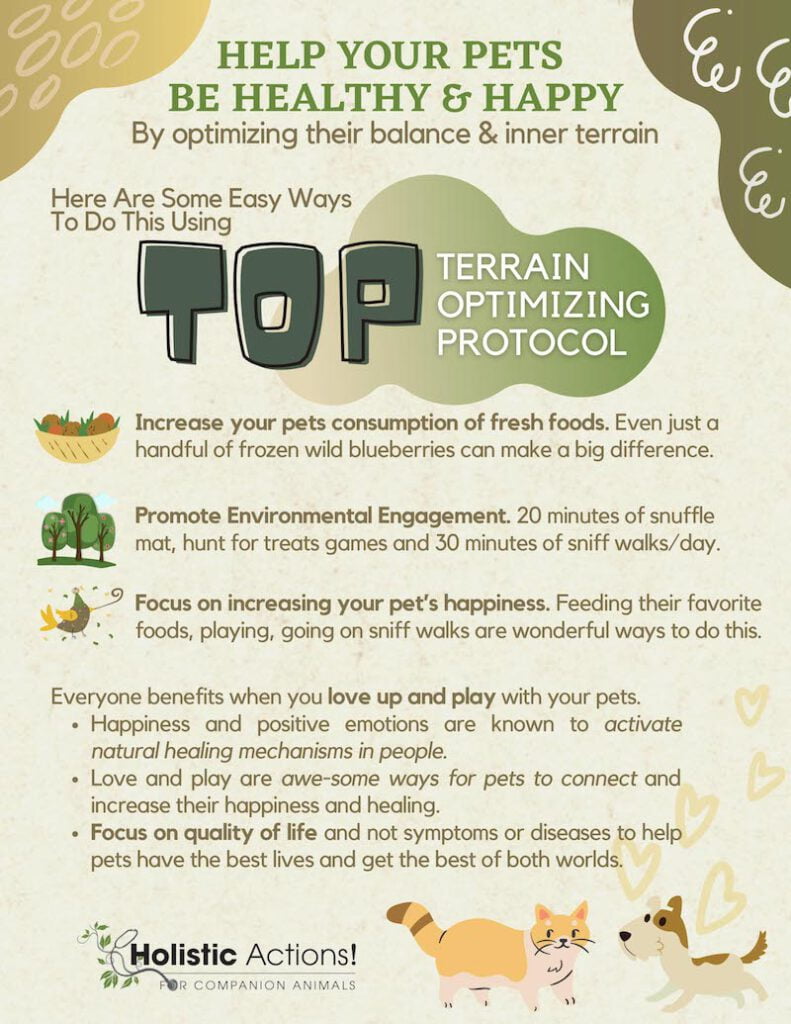Your pet’s susceptibility to dis-ease, like your own, depends on the degree to which they can maintain their inner balance (what is also called inner terrain) in the face of adverse environmental impacts. A balanced system is a resilient system since balance is expressed as a robust immune response. This means that building resilience and decreasing your pet’s susceptibility to dis-ease requires holistic actions that enhance and promote inner balance.
Understanding Susceptibility to Adverse Environmental Impacts (AEIs)
What do we mean when we talk about adverse environmental impacts (AEIs) and your pet’s ability to maintain their equilibrium (inner balance)? To give you an example, a high carbohydrate and ultra-processed diet represents an AEI that increases the chances for diabetes in cats, cancers in people, and obesity in pets and people.
However, how much impact this AEI has on the pet in question depends on all the different factors that go into maintaining inner balance: diet, exercise, exposure to toxins and pathogens, genetics, medical history, social environment, and so forth. Like people, pets have varying degrees of susceptibility to AEI that range from extreme susceptibility to minimal susceptibility. In the same way that the canary in the coal mine has an exquisite sensitivity to toxic fumes to the degree that even the tiniest exposure will result in death, dogs and cat also have unique susceptibility to various combinations of AEIs.

Immune Resilience and Your Pets Adaptability
Again, resilience refers to your pet’s ability to maintain its inner balance to defend itself against dis-ease and, if they do experience dis-ease, to recover from it. All living things are necessarily vulnerable to dis-ease and death, but resilience can be likened to the ability of a healthy tree branch to bend in the wind without being broken by it. A branch that is unhealthy and brittle lacks this ability to bend (to adapt) to the AEI of wind, and therefore quickly breaks.
The goal is to increase your pet’s resilience by making their system more able to adaptively “bend” to AEIs rather than being broken by them. A pet with inner balance will be far less susceptible to AEIs than a pet whose equilibrium has been compromised. (This accounts for why two pets can be exposed to the same AEIs and only one becomes sick.)
Remember, promoting inner balance requires optimizing as many aspects of your pet’s environment as possible: diet, exercise, exposure to toxins and pathogens, genetics, medical history, social environment, and so forth. In “Resilience and Immunity” the authors state (about people):
“This process is favored by…positive affect, optimism, and social support. Biopsychosocial studies on the individual qualities that promote resilience show that these factors help protect against the deleterious influences of stressors on physiology in general and immunity in particular…”
Building Resilience Even in Susceptible Pets
It is possible to build resilience even in susceptible pets by changing their inflammatory phenotype. The adaptive immune phenotype also influences the ability to recover from inflammation-induced symptoms.
In other words, by optimizing your pet’s environment to enhance inner balance and promote resilience, we can actually change gene expression. Genes may “load the gun,” so to speak, but your pet’s susceptibility to AEI’s largely determines whether or not the “trigger” is ever pulled.
Increases in susceptibility and immune “hyper-sensitivity” are seen in pets with allergies. These pets may get super itchy or have other allergic symptoms from common AEIs, such as pollens and foods. An extreme example of excess susceptibility in people is known as “environmental sensitivity.” People suffering with this condition lack the inner balance and resilience to protect themselves from even the most subtle AEIs like faint odors or EMFs.

Susceptibility, Individuality and Immunity
What is healthy for one pet may be harmful to another. Whether any environmental factor helps or hurts your pet is based on specific factors that make up their individuality.
What is healthy for one pet may be harmful to another.
Individuality has a specific scientific definition nowadays. It refers to all the molecular mechanisms responsible for the “heavy lifting” in your pets’ system. These are the processes which help every organ and system work well. When these mechanisms are in balance, animals don’t suffer from the hyper-sensitivity and excess susceptibility seen in allergic pets and are less prone to get an infection or any dis-ease. Another example of an environmental factor that helps one pet but can hurt another is vigorous exercise. It is known to build balance and immune resilience in most pets but can also cause pain and decrease quality of life in other pets such as those with arthritis.
The relationship between individuality and susceptibility is especially apparent in the immune system. Immune strength and resilience varies based on the individual. Immunologist Irun Cohen, MD says:
“The story of immunity is the story of self. The immune system, like the brain, creates, records and protects the individual.
…By its acts, the immune system defines the material components that make up the self. The immune system is the guardian of our chemical individuality; it is a system that eliminates parasitic bacteria and viruses, a system that rejects foreign cells, and tissues, a system that can destroy tumor cells raising from our own bodies. By deciding which macromolecules and cells are allowed residence within us, the immune system establishes the molecular borders of each person. In defending the individual, the immune system defines cellular individuality…”
Connecting the Dots for a More Powerful Understanding and Treatment Approach
Stuff like this is not only really cool for science nerds like me, but also can help guide pet parents to optimize the environment on behalf of their pets. (What needs to be optimized, according to your pet’s individuality, is their nutrition, activity levels, social environment, living environment, and so forth.)
The principles of individuality and susceptibility connect the modern science of molecular biology with the ancient wisdoms of medical arts like Traditional Chinese Medicine and Ayurveda. Homeopathy is another more modern method that is teachable and reproducible and which integrates elegantly and powerfully with the new knowledge about cellular individuality.
Take, for example, the incredibly cool fact that cell receptors enable these cells to respond as “individuals.” These receptors act like toll booths and are even called “Toll-Like Receptors” in the scientific literature. Receptors help control individual cellular responses that can create symptoms. Which symptoms are seen depends on individuality and susceptibility and can be modified by acupuncture, and other holistic approaches, including pranayama.
Pranayama is the ancient practice of working with the breath to use it as an ally for enhancing wellbeing, increasing inner balance, and promoting recovery from dis-ease. Pranayama and the recognition of individualized breathing patterns is an integral part of the ancient healing art of Ayurveda. Extensive research has been conducted on the effects of pranayama, and the finding are very compelling:
“In animals, pranayama-like breathing techniques can simply be used together with conventional medicine and have been shown to improve treatment outcomes as they have done in people for millennia.”
(For a much deeper dive into pranayama, see this article.)

Introducing, the Exposome
There’s one other modern molecular concept that takes this fascinating study of individuality and susceptibility one step further. These terms may seem vague and esoteric but are now well defined in current conventional scientific terms using something called the molecular susceptibility of the “exposome”.
What the heck is an exposome? you might be wondering? Well, the exposome is basically a fancy name for what we’ve been talking about all along. In other words, an exposome isn’t a “thing,” it’s a way to assess an individual’s susceptibility to AEIs that takes into account all the AEI’s an individual has already been exposed to throughout their life (The psychological equivalent of the exposome metric is the Adverse Childhood Experiences Score, or ACES, which adds up the total number of adverse experience people underwent in childhood to determine their susceptibility to future AEIs.)
It is critically important to understand that your pet’s exposome does not doom them to ill health or extreme susceptibility.
It is critically important to understand that your pet’s exposome, like a person’s Adverse Childhood Experiences Score, does not doom them to ill health or extreme susceptibility. But your pet’s exposome reflects their individual exposures to potential toxicity and AEIs. If this is high, such as for pets repeatedly exposed to toxins, you will have to work that much harder to optimize their environment with holistic actions that restore balance and promote resilience.
If you want a deeper understanding of the exposome, check out this article (it’s about people, not pets but the same concepts apply.)
Want Even More Support for Taking Holistic Actions to Optimize Your Pet’s Environment to Build Resilience and Decrease Susceptibility?
Pet parents and holistic veterinarians around the globe are already using our holistic perspective and approach to nurture optimal health for their companion animals. If you’re a pet parent, you can confidently take easy holistic actions to increase your pet’s inner balance, protect them from pathogens, and enhance their quality of life. These free, simple and 100% safe lifestyle tweaks can be easily implemented through The Terrain Optimizing Protocol. You’ll love the way it supports and fuels the natural healing ability of your pet’s body.

Holistic Actions! helps you get a big picture view of your pet’s symptoms to gain greater clarity about how to nurture optimal health.
Thank you for visiting us here at Holistic Actions! We wish you the best of luck on your holistic journey!
With care,
Dr. Jeff
